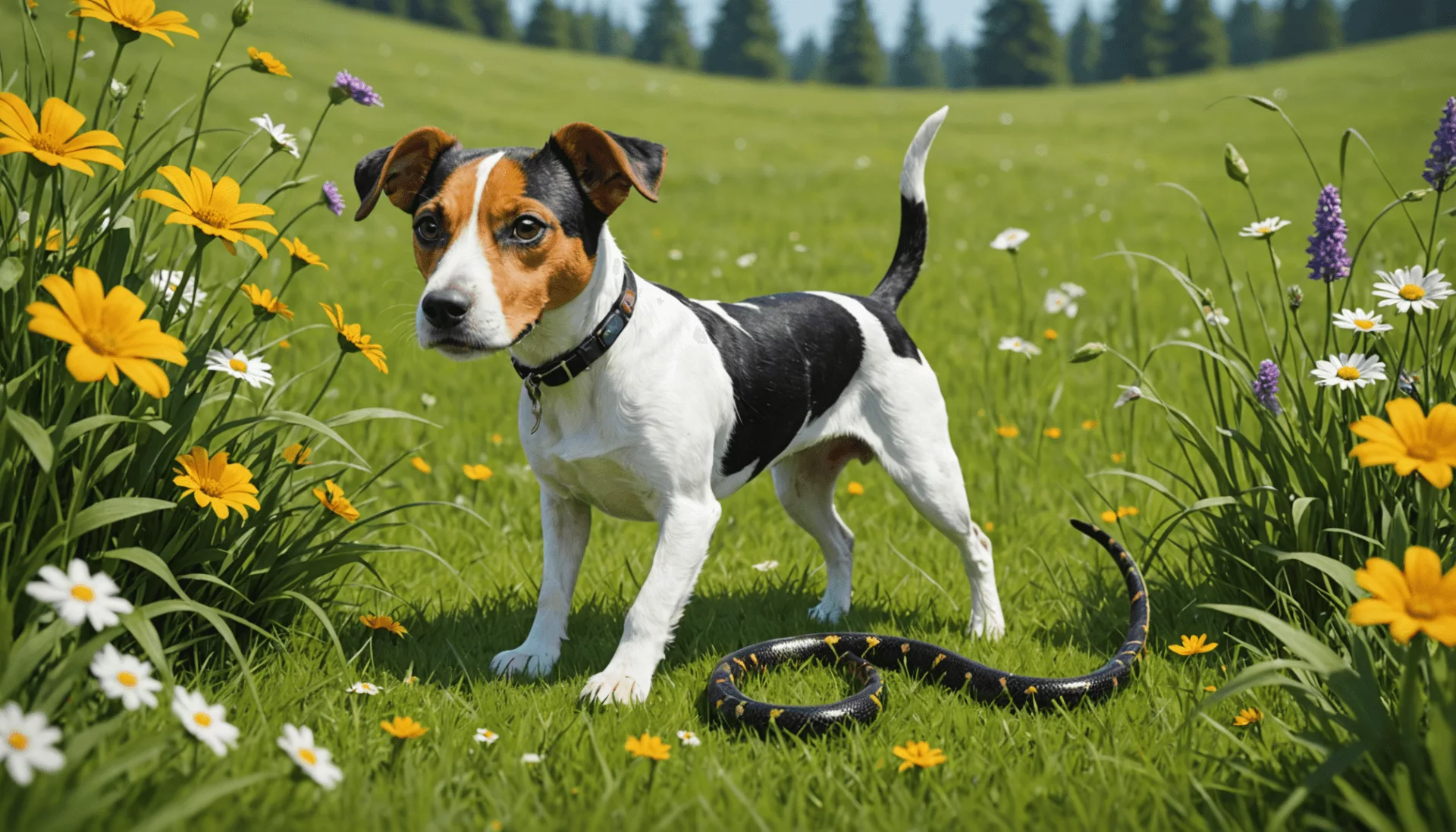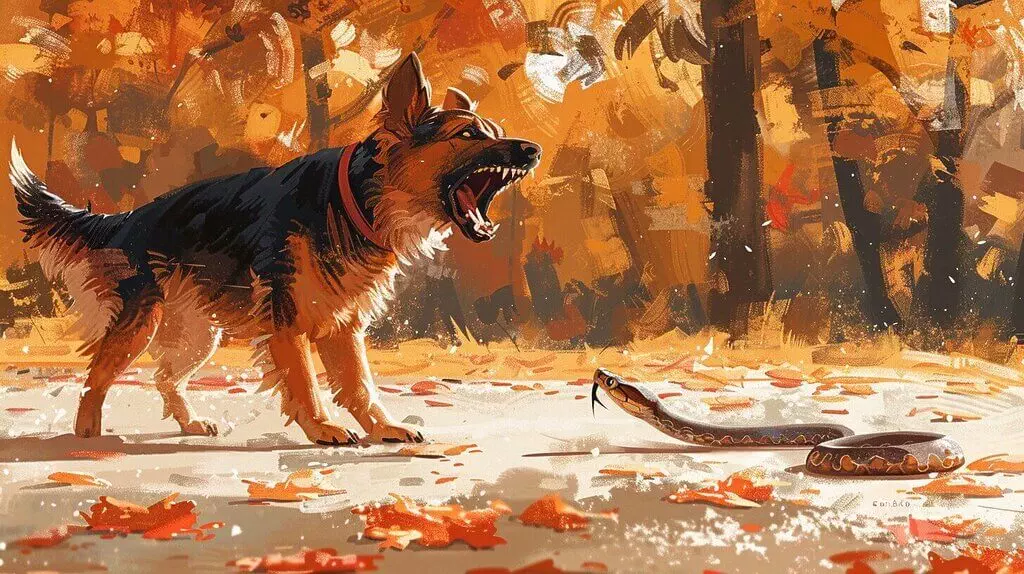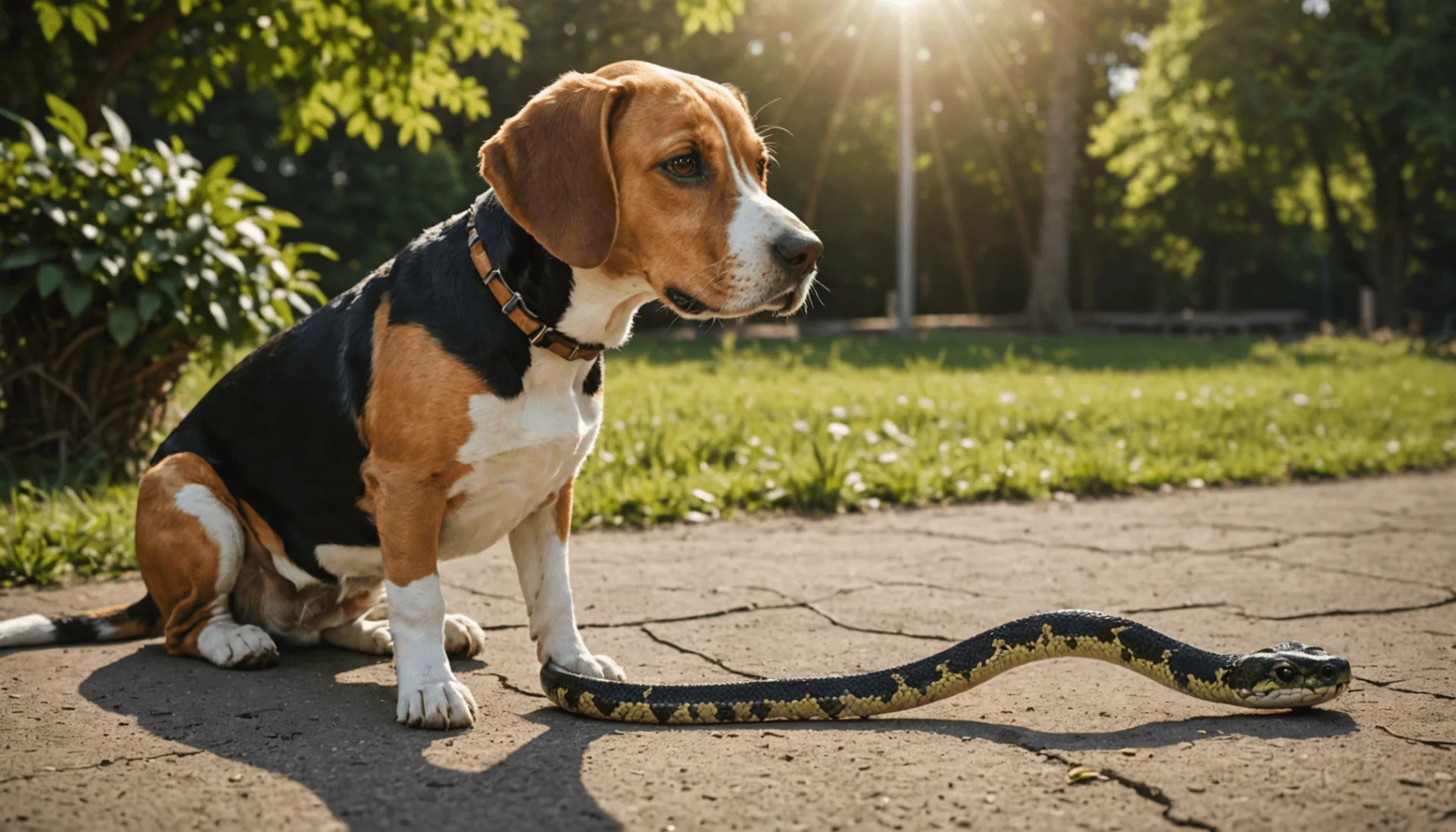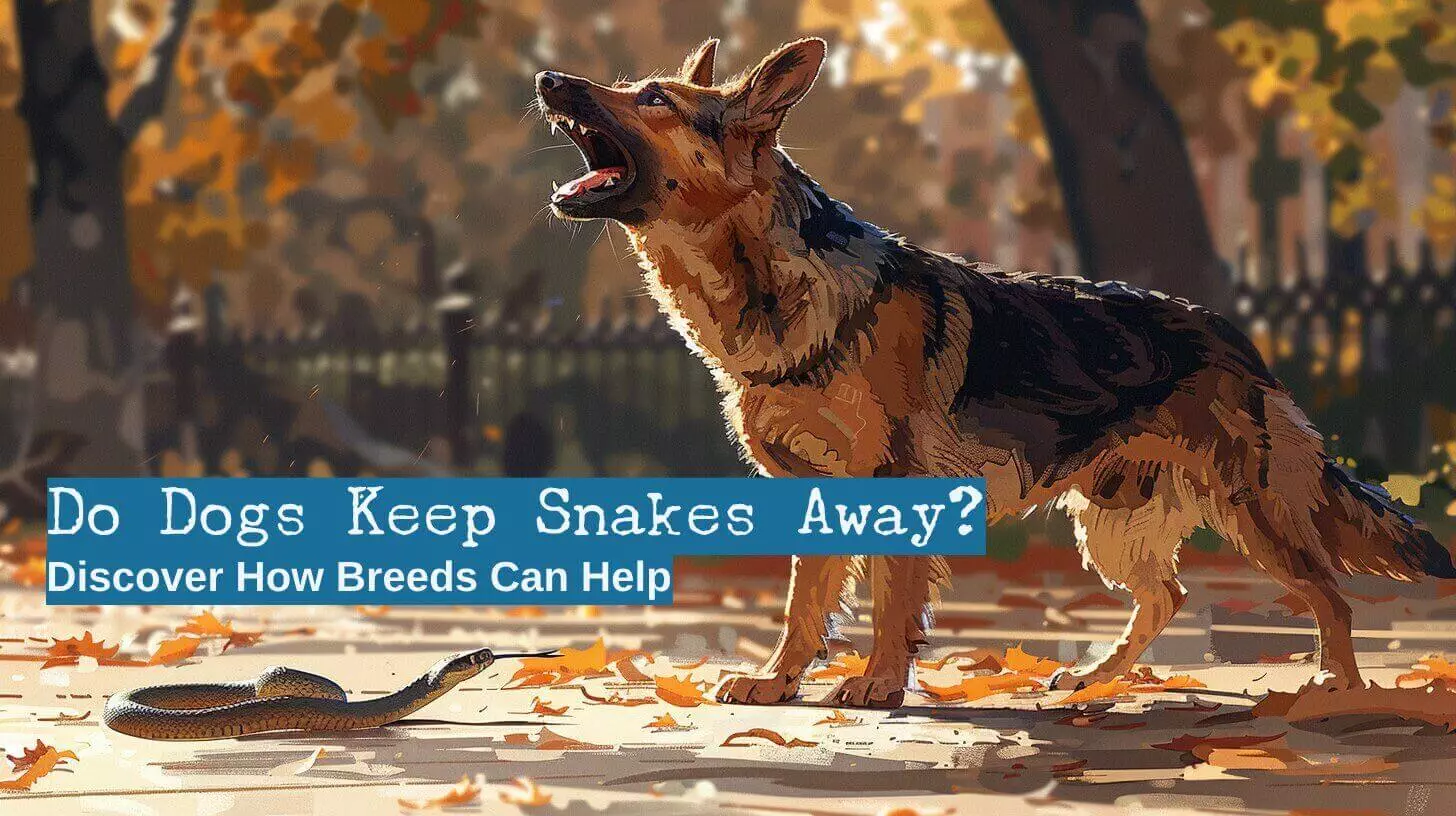Have you ever wondered if your furry friend can act as a protector against slithering snakes? The question of do dogs keep snakes away is more than just a curious thought; it’s a vital topic for pet owners, especially those living in snake-prone areas.
In this article, we’ll explore the effectiveness of dogs in snake control, the best breeds for this task, and how to train them to recognize and avoid snakes. We’ll also discuss the history of using dogs for snake deterrence and share expert insights on ensuring your dog’s safety around these creatures. Get ready to discover how your canine companion can become a natural barrier between your family and venomous snakes!
Do Dogs Keep Snakes Away?

How Effective Are Dogs in Keeping Snakes Away?
Dogs possess strong predatory instincts and acute senses. They can detect snakes by using their advanced sense of smell, which is about 40 times better than that of humans. This allows dogs to sense the presence of snakes before their owners do.
Additionally, dogs can hear sounds that humans cannot, making them more alert to snakes around them. Larger dog breeds, such as Rottweilers and American Bulldogs, are generally more effective in deterring snakes than smaller breeds. Their size and instincts make them more likely to scare off snakes, acting as a protective barrier for their families. Therefore, having dogs around can serve as an effective deterrent for snakes in many situations. [Mynatureguard]
The History of Using Dogs for Snake Control
Historically, dogs have played important roles in pest control, including keeping snakes away. Many rural and farming communities have used dogs to protect livestock and humans from snake encounters.
For instance, farmers relied on dogs to alert them about snakes hiding in fields or near barns. This long-standing tradition highlights the valuable relationship between humans and dogs in managing wildlife threats. The innate instincts of dogs to chase and bark at potential predators, including snakes, have made them indispensable for people living in snake-prone areas.[Wagwalking]
The Best Dog Breeds for Snake Prevention

Top Breeds Known for Their Ability to Keep Snakes Away
Certain dog breeds have unique traits that help them keep snakes away. Rottweilers, German Shepherds, and Doberman Pinschers are often noted for their protective instincts. These large dogs possess a strong territorial nature. Their keen senses allow them to detect snakes early, making them effective guardians.
Additionally, breeds like Jack Russell Terriers and Fox Terriers are known for their alertness and agility, which help in chasing away snakes. Studies show that these breeds tend to bark at approaching snakes or display alertness, deterring snakes from getting too close. [Mynatureguard]
Characteristics of a Good Snake Prevention Dog
Effective snake prevention requires certain key characteristics in a dog. A strong territorial instinct is essential, as dogs with this trait perceive snakes as intruders. High energy levels are also important, allowing dogs to respond quickly to potential threats.
Trainability plays a significant role; a dog that can learn commands and cues is more effective in snake detection. Furthermore, a keen sense of smell enhances their ability to detect snakes before any encounters occur. Dogs with these characteristics provide a barrier between snakes and their owners, contributing to a safer environment around homes and yards. [Wagwalking]
Table: Comparison of Dog Breeds for Snake Prevention
| Dog Breed | Territorial Instinct | Energy Level | Trainability | Notable Trait |
|---|---|---|---|---|
| Rottweiler | High | High | Moderate | Strong protective instinct |
| German Shepherd | High | High | High | Excellent sensing abilities |
| Doberman Pinscher | High | High | High | Agile and quick to react |
| Jack Russell Terrier | Moderate | Very High | High | Alert and quick to chase |
| Fox Terrier | Moderate | High | Moderate | Strong prey drive |
Key Traits of Effective Snake Prevention Dogs
- Territorial Instinct: Dogs should see snakes as intruders.
- Energy Level: A high-energy dog reacts quickly to threats.
- Trainability: Dogs that learn commands are more effective.
- Keen Sense of Smell: A strong sense of smell helps detect snakes early.
- Size and Strength: Larger dogs can intimidate snakes and act as a barrier.
Why Some Breeds Are More Effective at Keeping Them Away
Some dog breeds are more effective at deterring snakes due to their instincts and physical attributes. Rottweilers and German Shepherds have strong prey drives and are naturally alert. Their size can intimidate snakes, prompting them to retreat.
Certain breeds also possess better instincts for detecting wildlife, including snakes. Dogs with higher intelligence and problem-solving skills can be trained more effectively to recognize and respond to snakes. This combination of size, strength, and instinct makes specific breeds particularly adept at keeping snakes away, ensuring greater safety for their families. [Mynatureguard]
Training Dogs to Keep Snakes Away

How to Train Your Dog to Recognize and Avoid Snakes
Training a dog to recognize and avoid snakes is vital for pet owners in snake-heavy areas. Start by safely exposing your dog to the scent of snakes. You can use scent samples from different types of snakes. Introduce these scents gradually to prevent overwhelming your dog.
Positive reinforcement is essential during training. Whenever your dog shows hesitation or avoids the snake scent, reward them with treats, praise, or playtime. This helps create a positive association with the snake smell. Regular practice reinforces their learning.
Keep training sessions short, lasting only 5 to 10 minutes, a few times each week. Gradually increase the complexity by introducing the scent in various locations. Always monitor your dog’s behavior and ensure they feel comfortable throughout training.
This training not only keeps your dog safe but also protects their owners and kids from possible snake encounters. Dogs have acute senses, allowing them to detect snakes before humans can. By training them to recognize these scents, they become vigilant guardians against snakes in their surroundings.
Techniques to Enhance Your Dog’s Sense of Smell for Pest Control
Enhancing your dog’s sense of smell can greatly improve their ability to detect snakes. One effective technique is creating scent trails. Use cotton balls dipped in snake scents and drag them along the ground in an outdoor area. This helps your dog follow the scent and engage their natural instincts.
Reward your dog with treats whenever they successfully navigate the scent trail. This reinforces positive behavior and encourages them to keep honing their skills. Additionally, use different snake scents during training to keep the experience fresh and engaging.
Introducing various environments can also help. Take your dog to areas with tall grass, brush piles, or spots where snakes might hide. Allowing them to explore these areas helps develop their natural instincts for spotting potential threats.
Regular exercises that stimulate your dog’s sense of smell can be very beneficial. Engaging them in scent games, like hide-and-seek with their favorite toys or treats, enhances their sniffing skills. These activities are both fun and practical, allowing dogs to exercise their keen sense of smell while enjoying playtime.
What Not to Do When Training Your Dog for Snake Awareness
Avoid exposing dogs to live snakes without proper precautions. This can lead to negative experiences, resulting in fear or aggression, which is dangerous. Always prioritize your dog’s safety and comfort during training.
Harsh training methods or punishment should also be avoided. This can create anxiety and distrust between you and your dog. Instead, focus on positive reinforcement, which builds a strong bond and encourages learning.
Don’t rush the training process. Each dog learns at its own pace, so patience is key. Gradually increase the complexity of training sessions, allowing your dog to become familiar with concepts before introducing challenges.
Finally, ensure the training environment is safe and distraction-free. A calm setting helps dogs focus and reduces the risk of accidents. By following these guidelines, you can effectively train your dog to recognize and avoid snakes in a supportive manner.
Understanding Snake Behavior and Dog Interaction

How Dogs React to Snakes: Fear vs. Curiosity
Dogs can react to snakes with fear or curiosity. When a dog sees a snake, it may feel scared because snakes can be dangerous. This fear can cause behaviors like barking, cowering, or trying to run away. In contrast, some dogs might approach the snake out of curiosity. Their interest may come from their natural hunting instincts.
A dog’s reaction often depends on its past experiences. For example, a dog that has never seen a snake may be more curious than a dog that has had a scary encounter.
Signs Your Dog is Afraid of Snakes
Recognizing when a dog is afraid of snakes is important. Signs of fear can include:
- Cowering or hiding behind you.
- Barking loudly or growling at the snake.
- Trying to flee or run away from the area.
- Panting or showing signs of anxiety.
If you notice any of these behaviors, calmly remove your dog from the area. This helps reduce stress and keeps your dog safe from potential snake encounters. [dogdecoder]
What You Should Do if Your Dog Encounters a Snake
When your dog encounters a snake, your response is crucial. Here are steps to follow:
- Stay calm: Dogs can sense your anxiety. Remaining calm helps your dog feel secure.
- Call your dog: Use a friendly, firm voice to call your dog back to you.
- Avoid sudden movements: Quick actions can startle the snake and lead to a defensive strike.
- Leash your dog: If trained, put your dog on a leash to prevent further encounters.
Act quickly but carefully. Removing your dog from the area helps ensure safety for both of you. [Aspca]
| Dog Behavior | Possible Sign or Reaction |
|---|---|
| Cowering | Hiding behind owner |
| Barking | Growling at the snake |
| Trying to flee | Running away from area |
| Panting | Showing signs of anxiety |
Expert Insights on Dogs and Snake Safety

Future Trends in Training Dogs for Snake Awareness
As snake encounters grow more common in some areas, training dogs to recognize and avoid snakes is crucial. Future trends may include using technology to assist in training. For instance, training apps could help owners teach their dogs to respond to snake detection cues.
Moreover, dog trainers may focus more on positive reinforcement strategies. This approach encourages dogs to identify snakes without instilling fear. Workshops and community events could also raise snake awareness among dog owners, emphasizing safety in snake-prone areas.
Expert Recommendations for Dog Owners Concerned About Snakes
Experts recommend several strategies for dog owners living in snake-prone regions. First, dogs should be trained to recognize and avoid snakes. Positive reinforcement methods can help dogs learn to alert their owners when they sense a snake nearby.
Second, keeping yards tidy can reduce hiding spots for snakes. This includes clearing brush piles, leaf piles, and other debris. Lastly, experts suggest monitoring the area for snake activity. Observing signs like tracks or shed skins can indicate the presence of snakes.
| Recommendations for Dog Owners | Benefits |
|---|---|
| Train dogs to recognize snakes | Helps in early detection |
| Keep yards tidy | Reduces hiding spots for snakes |
| Use positive reinforcement | Encourages safe behaviors |
Expert Quotes on Dog Training and Snake Behavior
Trainers stress the importance of understanding dog behavior during snake encounters. Recognizing a dog’s body language provides valuable insights. Signs of fear, like backing away or whining, indicate that a dog may have spotted a snake.
Trainers also advocate for consistent training sessions to reinforce positive behaviors. Ensuring dogs remain alert yet calm around snakes can enhance their protective instincts. This training makes them effective deterrents against snakes.
Long-term Considerations for Dog Owners in Snake-Prone Areas
Living in snake-prone areas requires ongoing vigilance. Dog owners should continuously assess their yards for potential snake habitats, such as wood piles and brush. Regular training sessions can reinforce a dog’s skills in identifying and reacting to snakes.
Long-term studies may help determine the effectiveness of certain breeds and training techniques. Investing in a snake bite kit and being knowledgeable about local snake species can provide added peace of mind.
Conclusion
In summary, dogs can be great help in keeping snakes away! Some breeds, like the Jack Russell Terrier and the Fox Terrier, have a natural instinct and strong prey drive that help them detect and deter snakes. Training your dog to recognize and avoid snakes is also important, as their acute senses can alert you to potential dangers in your yard.
Remember, understanding snake behavior and your dog’s reactions is key to keeping both pets and families safe. With the right dog and training, you can create a safe barrier between your loved ones and venomous snakes. So, whether you’re considering getting a dog or training your current one, there’s always more to learn about the fascinating world of dogs and their protective instincts! Keep exploring and stay curious!
FAQs
1. Can dogs keep snakes away from my property?
Yes, certain dog breeds like Rottweilers, German Shepherds, Doberman Pinschers, Jack Russell Terriers and Fox Terriers have an innate sense of alertness and can deter snakes by acting as guard animals, particularly around areas like garden beds or the chicken coop.
2. Are dogs effective in keeping venomous snakes away?
Dogs can help keep poisonous snakes like eastern brown or rattlesnakes away, but they may not always be able to prevent a snake from striking. A dog’s fear of snakes and sharp claws can act as a deterrent, but it’s not a foolproof method.
3. Do certain dog breeds do better at keeping snakes away?
Yes, breeds like Rottweilers and German shepherds are known for their natural hunting instincts and ability to spot and chase away snakes, especially in areas like vegetable gardens or near bird feeders.
4. Can dogs protect kids from snakes?
Dogs, especially those with a strong guard animal instinct, can help keep kids safe from deadly snakes by alerting to their presence and deterring them, but it’s important to supervise interactions in snake season and use additional snake repellent products for extra safety.
5. Do snake repellent products work with dogs around?
Some commercial snake repellents are pet-safe, but it’s important to choose products carefully, as certain natural repellents (like plantain plant or rock salt) are safer for both pets and the environment. Always check for ingredients that are harmful to dogs.

